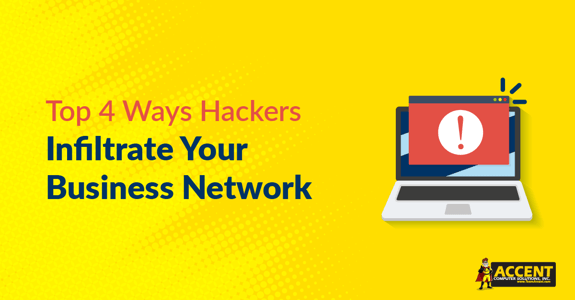Cybercrime is on the rise and is making the news – in fact, new cyber attacks are being reported on a scale never before seen in the business world. These criminals are getting bolder and more sophisticated, and if the success of your business is contingent on the availability and security of your data, then you need to ensure you are protected against these attacks.
You may be thinking that well-orchestrated cyber crime only affects large companies, but for every cyber security story you hear on the news, there are thousands of similar untold stories from small and midsize businesses. Often times they’re preying on your employees.
Many businesses think they have IT security covered, so how are hackers still getting into networks?
1. Email Attachments
The number one way hackers get into business networks is through disingenuous email attachments. If an employee receives what appears to be a legitimate message from a vendor containing an “invoice” or from a bank containing a “statement,” their first reaction will be to open it so that the contents may be acted upon. Unfortunately, when these attachments are opened, malicious software is installed that creates vulnerabilities in your network.
It is essential to train employees to always check the validity of an attachment before it’s opened, or a link before it is clicked. A few seconds of diligence will pay dividends in the long run.
2. Personal Email
Productivity concerns aside, employees checking their personal email at work could pose huge problems. You could have the best email filters money can buy, but personal inboxes bypass security barriers, such as spam filters, that you have in place to keep your network safe.
If a user interacts with a malicious email in their personal inbox while connected to your IT systems, any harm it causes will be done to your company’s network. The only redemption is that recipients generally won’t open emails from people they don’t know, and they are likely to recognize that in their personal inbox.
3. Working Remotely
Employees work remotely now more than ever.
It’s great that employees are able to work from coffee shops, hotels, and homes just like they’re at the office. However, this also means that they are accessing company information in a less secure manner. It’s unlikely that an employee’s home network has the same security measures in place that they have at the office, such as web filters and firewalls.
The same goes for connecting to a WiFi network at a coffee shop, hotel, or other public places. With little to no security, a user connected to public WiFi is an easy target. Knowing how and when to use public WiFi for work purposes will help keep your network safe.
Related Resource: Remote Workers and Security: Staying Safe in Changing Times
4. Mobile Devices
Another threat is the availability of company data through mobile devices. Mobile devices are as susceptible as breach points for a couple of unique reasons.
First, many people do not have a password or any other security on their mobile devices.
Second, mobile devices are more likely to get lost or stolen than corporate workstations.
Finally, users generally don’t consider their mobile devices to be “real technology” to the same degree as their laptop or desktop. This means that they are much more likely to load the latest games and apps available on their device. This increases risk considerably since many people don’t pay much attention to the source or what information an app is requesting access to before they download it.
The unfortunate reality about IT security is that we’re fighting an uphill battle.
Thousands of engineers worldwide are actively combatting threats and working on prevention, but there are also thousands of criminals poking holes in the barriers.
If you want to have a fighting chance at keeping your business safe, your in-house or outsourced IT support team needs to make sure your systems are following IT security best practices and are kept as up-to-date as possible.
Having the proper IT security measures in place is critical to mitigating the risk of a hack attempt. It’s also more important than ever that your employees be trained on acceptable use of your systems and how to recognize threats so they don’t accidentally invite them in.
Have a conversation with a trusted business technology consultant about your cybersecurity risk and make sure your organization is as protected as possible.


